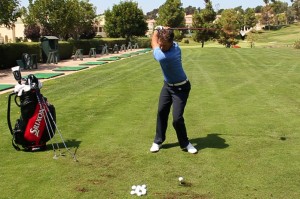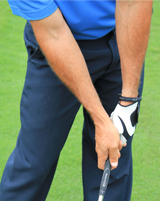Golf Downswing Tips
The downswing is one of the most talked about parts of the golf swing. You could write a book about all the minute details that go into a perfect golf downswing (and some people have), but this kind of detail often causes more confusion and problems in the golf swing that it’s worth.
Because my goal is to help you play better golf I’m not going to go into that kind of excruciating detail (that just get’s you thinking about too many things). Instead I’m going to keep this golf downswing explanation simple and to the point.
Initiating The Golf Downswing
 The golf downswing is defined as the part of the swing that starts from the uppermost position of the golf club (the end of the backswing) until impact.
The golf downswing is defined as the part of the swing that starts from the uppermost position of the golf club (the end of the backswing) until impact.
Your downswing should start from the ground up. This prevents your arms from initiating the action.
Feel the downswing through your feet, knees, hips, and torso. The pivoting of your hips toward the target is what starts the downswing (it will pull your arms where they need to go).
When it comes to your hands and arms let gravity do the work. Don’t try to create club head speed from the top of your swing. Instead allow your core pivot to build up or develop club head speed throughout the downswing.
A good thing to keep in mind is to start slow from the top. Don’t jerk the club down from the top of your back-swing.
Arm and Wrist Position During the Golf Downswing
 Your wrists should maintain a lag angle (hands in front of the club head) through the entire downswing and into impact.
Your wrists should maintain a lag angle (hands in front of the club head) through the entire downswing and into impact.
This will prevent you from casting (also known as club head throw away). Casting causes your shots to be weak and inconsistent.
To maintain this lag angle you will need to keep your left wrist (right wrist for lefties) all the way through the downswing (and through impact).
If you are not sure if you are casting or simply want to perfect your wrist conditions and ball striking check out this instant feedback ball striking drill.
You also need to keep your right arm (left arm for lefties) bent and tucked into your body through the downswing (as you can see in the image above).
If you straighten out your right arm you will loose power and force your hands to cast the club. Tucking your right elbow in also helps guide your hands, “drop into the slot.” This is a phrase pros use to describe the path of the hands through the downswing.
If you are not sure what “tucking your elbow” means check out this short video tip.
A great way to make sure you keep that lag angle with your hands is to feel pressure on your right index finger. If you don’t feel pressure there in your downswing you are likely casting and throwing away your power. Follow the link for a short video explanation of lag angle and pressure on your index finger.
Golf Downswing Body Position
 During the downswing your weight will be shifting from your back leg to your front leg. This weight shift is a big part of the power in the golf swing.
During the downswing your weight will be shifting from your back leg to your front leg. This weight shift is a big part of the power in the golf swing.
Your head should stay behind the ball through the whole downswing and your spine should be slightly tilted back towards your back leg. The Image on the right shows how this will look.